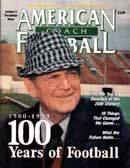AMERICAN FOOTBALL MONTHLY THE #1 RESOURCE FOR FOOTBALL COACHES
Article CategoriesAFM Magazine
|
Walking the SidelinesTop 25 Coachesby: Gene Frenette Florida Times-Union © More from this issue Every week during college football season, fans routinely cast their eyes on somebody's Top 25 poll - Associated Press, ESPN/USA Todayand several lesser-known ranking systems now incorporated into the Bowl Championship Series formula - to see where their respective schools might stack up with the rest of the nation. These polls are anything but perfect. They spur controversy, often drawing the ire of people in places like Blacksburg, Lincoln, Knoxville, Manhattan and State College who feel their schools should be ranked higher or somebody else's lower. But the polls do serve one useful purpose: they get folks talking about college football. So with that in mind, we'd like to present a different kind of Top25 poll, one that is sure to pique the curiosity of fans who bleed notonly their school's colors, but have strong ....The full article can only be seen by subscribers.
|
|
|||||||
| HOME |
MAGAZINE |
SUBSCRIBE | ONLINE COLUMNISTS | COACHING VIDEOS |
Copyright 2025, AmericanFootballMonthly.com
All Rights Reserved





